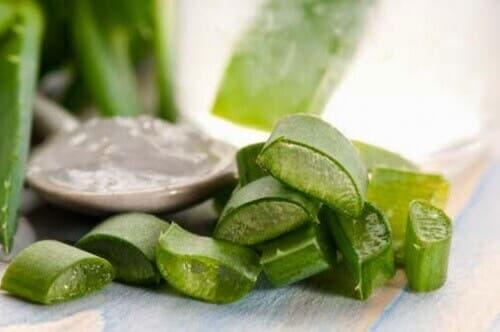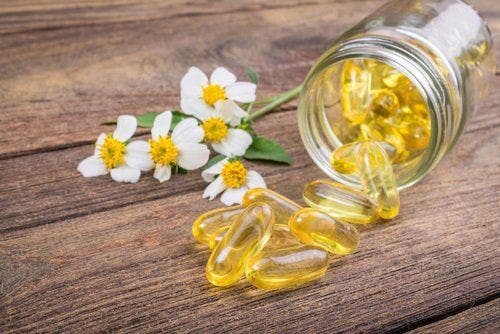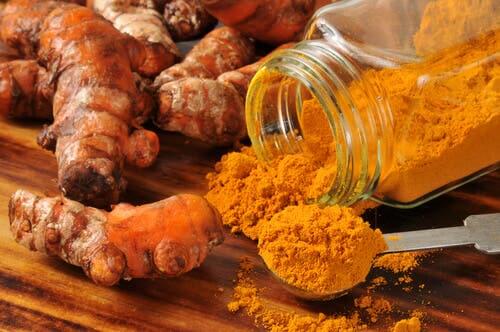Natural Seborrheic Dermatitis Remedies

Natural seborrheic dermatitis remedies aren’t exclusively conventional shampoos or creams. Although they’re very effective, some natural solutions also yield good results. Are you interested in trying them out? In this article, we want to share five alternatives with you.
What’s seborrheic dermatitis?
Seborrheic dermatitis is a common skin disorder that mainly affects the scalp. Although its exact cause is unknown, it’s believed to be related to a Malassezia fungus infection and immune system alterations.
Although treatments can keep your symptoms under control, the disease can’t be completely cured. Therefore, those who suffer from it should take some basic steps to reduce the reappearance of outbreaks. Below, discover some home remedies.
Five natural seborrheic dermatitis remedies
Remedies for seborrheic dermatitis aim to help curb symptoms such as scaly patches, reddened skin, and, also, dandruff. In addition, they facilitate the detachment of dead cells and minimize excessive sebum production.
1. Aloe vera

The gel the aloe vera plant contains has beneficial skin health applications. According to research, its extracts are useful in the treatment of seborrheic dermatitis. In fact, in addition to calming your symptoms, it prevents outbreaks of this disease.
How to use it
- Firstly, buy aloe vera supplements and consume them by following the instructions
- If you prefer to use it in its natural form, extract fresh aloe vera gel and apply it to the affected areas
- Repeat the remedy every day until you see an improvement
Read on to learn more: The Differences between Atopic and Seborrheic Dermatitis
2. Tea tree essential oil
Due to its anti-fungal and anti-inflammatory properties, tea tree essential oil stands out as one of the best remedies for seborrheic dermatitis. Its topical application reduces discomfort such as itching, redness, and scaly patches.
How to use it
- Firstly, dilute six drops of tea tree essential oil in a couple of tablespoons of base oil, such as olive or coconut oil
- Then, rub the treatment on the areas affected by dermatitis
- Massage for a few minutes and leave on
- Finally, rinse after 15 or 20 minutes
3. Remedies for seborrheic dermatitis: Vitamin E oil

Consuming and topically applying vitamin E has interesting skin health benefits. In this particular case, it helps reduce scalp inflammation and irritation. In addition, it facilitates the detachment of dead skin and accelerates the recovery of affected tissues.
How to use it
- Firstly, take a vitamin E capsule and dilute it in your regular shampoo
- If you prefer, combine the content of a vitamin E capsule with a tablespoon of coconut oil and use the preparation to massage the affected parts of your scalp
- Finally, don’t forget to take vitamin E supplements
You should also read: Effective Natural Remedies for Seborrheic Dermatitis
4. Avocado oil
Due to its high content of omega-3 fatty acids, amino acids, and antioxidants, avocado oil is ideal against seborrheic dermatitis and other skin conditions. Massaging it onto your scalp helps to soothe redness, burning, and itching.
How to use it
- Firstly, combine equal parts of avocado oil with olive oil
- Then, carefully rub the product onto the scabs and affected areas
- After that, leave it on for 15 minutes and massage with a soft brush to facilitate the removal of dead skin
- Finally, rinse with warm water
5. Turmeric

People have used turmeric extracts for many years as one of the seborrheic dermatitis remedies. Since its active compounds are anti-inflammatory, it improves the state of the skin in areas irritated by this condition. It even helps to prevent new outbreaks.
How to use it
- Buy turmeric extracts and consume 350 to 500 mg every day. Avoid this remedy if you have gallbladder problems or if you’re taking any drugs. In the latter case, consult your doctor.
- You can use it topically by mixing the powdered root with olive or coconut oil. Massage for a few minutes and rinse.
It’s important to note that seborrheic dermatitis remedies can have different effects on everyone. Since there isn’t enough evidence to support them, it’s always a good idea to see your doctor for other alternatives.
Also, to avoid unwanted effects, it’s best to do a little test before using the preparation in its entirety. If you don’t see any unwanted reactions after 20 minutes, you can then proceed to use it.
All cited sources were thoroughly reviewed by our team to ensure their quality, reliability, currency, and validity. The bibliography of this article was considered reliable and of academic or scientific accuracy.
- Surjushe, A., Vasani, R., & Saple, D. (2009). Aloe vera: A short review. Indian Journal of Dermatology. https://doi.org/10.4103/0019-5154.44785
- Feily, A., & Namazi, M. R. (2009). Aloe vera in dermatology: a brief review. Giornale Italiano Di Dermatologia e Venereologia : Organo Ufficiale, Societa Italiana Di Dermatologia e Sifilografia.
- Cox, S. D., Mann, C. M., Markham, J. L., Bell, H. C., Gustafson, J. E., Warmington, J. R., & Wyllie, S. G. (2000). The mode of antimicrobial action of the essential oil of Melaleuca alternifolia (Tea tree oil). Journal of Applied Microbiology. https://doi.org/10.1046/j.1365-2672.2000.00943.x
- Carson, C. F., Hammer, K. A., & Riley, T. V. (2006). Melaleuca alternifolia (tea tree) oil: A review of antimicrobial and other medicinal properties. Clinical Microbiology Reviews. https://doi.org/10.1128/CMR.19.1.50-62.2006
- Koh, K. J., Pearce, A. L., Marshman, G., Finlay-Jones, J. J., & Hart, P. H. (2002). Tea tree oil reduces histamine-induced skin inflammation. British Journal of Dermatology. https://doi.org/10.1046/j.1365-2133.2002.05034.x
- Keen, M., & Hassan, I. (2016). Vitamin E in dermatology. Indian Dermatology Online Journal. https://doi.org/10.4103/2229-5178.185494
- Lin, T. K., Zhong, L., & Santiago, J. L. (2018). Anti-inflammatory and skin barrier repair effects of topical application of some plant oils. International Journal of Molecular Sciences. https://doi.org/10.3390/ijms19010070
- Thangapazham, R. L., Sharma, A., & Maheshwari, R. K. (2007). Beneficial role of curcumin in skin diseases. Advances in Experimental Medicine and Biology. https://doi.org/10.1007/978-0-387-46401-5_15
- Kguyen, T. ., & Friedman, A. . (2013). Curcumin: a novel treatment for skin-related disorders. Journal of Drugs Dermatology.
This text is provided for informational purposes only and does not replace consultation with a professional. If in doubt, consult your specialist.








